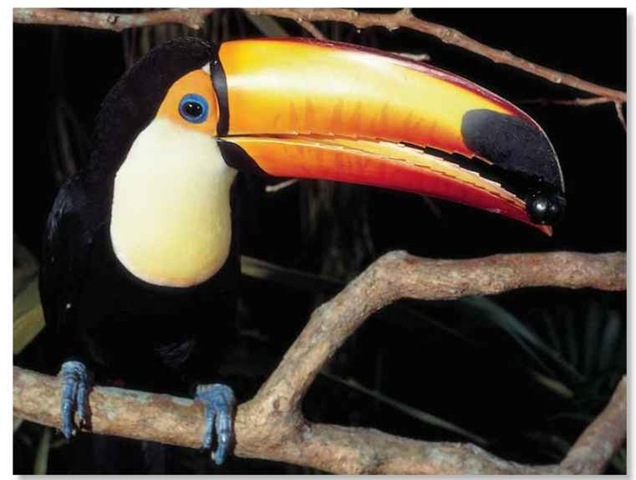ORDER
Piciformes
FAMILY
Ramphastidae
GENUS & SPECIES
key features
The largest toucan; known throughout the world as an exotic symbol of South American forests Its bill is a lightweight and dexterous tool for plucking and manipulating fruit and seeds Also uses bill to kill small animals and in playful bouts of bill-fencing and mutual preening
where in the world?
Found in South America, from Guyana south across much of southeastern Brazil to northern Argentina, and into westernmost Bolivia; its range excludes the heart of the Amazon rainforest

LIFECYCLE
Of all the South American toucans, the toco, with its bold bib and glaring eye, has the greatest liking for open woodland and is most likely to be seen near human settlement.
HABITAT
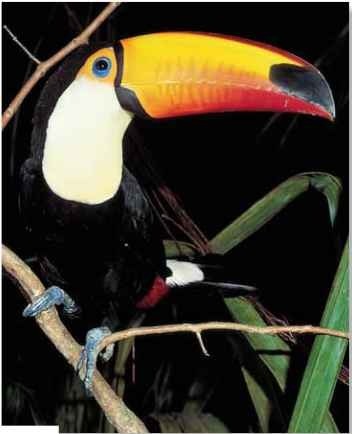
A Show off
The toco toucan is easy to spot, even in the treetops.
Many species of toucan seek refuge in the canopy of tropical forests, but the toco toucan prefers relatively open habitats and is absent from much of the Amazon rainforest, preferring savannah woodland, palm groves, riverside trees and forest edges.
This toucan is fond of coconut and sugar plantations and clearings, and is a familiar sight around villages and farms. It is however; entirely dependent on large trees, as it feeds, sleeps and nests high in the treetops. One of the main limitations on where the toucan can live is the availability of nest sites — the species uses tall, living trees with natural holes just large enough to accommodate it.
CONSERVATION
The toco toucan remains a widespread bird. Its dislike of dense forest has enabled it to escape the fate of many other toucans threatened by destruction of their rainforest home to make way for farmland and villages.The toco toucan is also able to adapt to man-made habitats, such as commercial plantations. But it soon vanishes from those areas where all the large trees have been felled.
The toco toucan bathes high above ground by splashing its plumage in rainwater-filled hollows of a tree’s branch or trunk.
The garish colors and huge bill size of the toco toucan serve to intimidate small birds, so the toucan can raid their nests.
Adult toco toucans make unusually restless parents. A toucan rarely sits on its eggs for more than an hour before letting its mate take over.
FOOD & FEEDING
The toco toucan feasts on berries, seeds and fruits — especially figs — that cluster in treetops. Much of these develop on slender twigs that are too fragile for the bird’s weight, but the toucan can use its long bill to reach out from a sturdy branch and grab a juicy prize. Although clumsy looking, the bill is dexterous enough to handle small morsels of food with finesse.
The toucan supplements its vegetarian diet by seizing spiders and insects, and on occasion, tree-living snakes and lizards. It often steals the eggs and young of other birds as well.
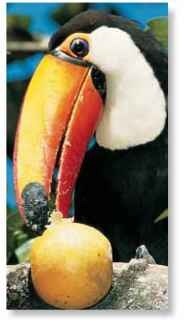
A Sweet reward The toucan breaks up fruits too large to swallow.
BEHAVIOR
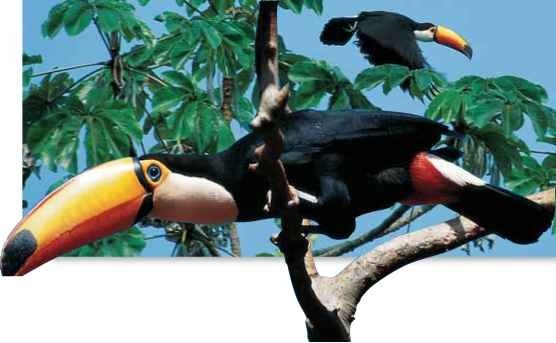
A If you’ve got it, flaunt it Flocks of toucans clamber about, and keep in touch by making toadlike croaks.
The toco toucan roosts on a large branch at night, twisting its head so that its bill nestles in the warm feathers on its back. At first light, the bird rouses and begins searching for food. The toucan stays among the topmost foliage, and moves by hopping from branch to branch rather than by flapping.
Small groups of toco toucans often indulge in “playful” antics: the birds jump around each other and stage mock push-and-shove contests with their bills. They also engage in bouts of mutual preening, where one bird stays still while a companion grooms its plumage. Toucans remove dust and sticky seeds by gently nibbling one another’s feathers with the tips of their mandibles.
BREEDING
Having found a suitable cavity high up a tree trunk, the male and female toco toucan do little to prepare their nest.They just use decaying wood chips to make a bedding for the two to four eggs. While they incubate their eggs, the toucans regurgitate seeds, making the nest lining deeper.
In a little over two weeks, the blind and featherless nestlings hatch in the dark refuge of the nest. Young toucans develop slowly compared to most perching birds; about seven weeks pass before the brood emerges into the outside world.
Equal partners The parents take turns guarding the young and gathering food.
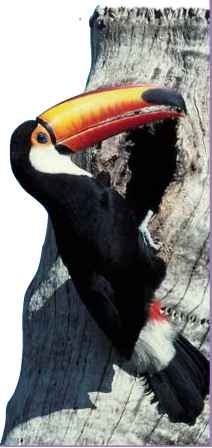
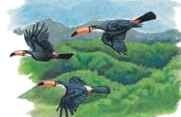
Search…
Three toco toucans fly to find a fruiting tree.They may be joined by other toucans, but feeding parties rarely exceed 12 birds.
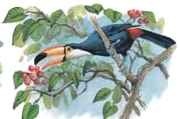
Stretch…
One grasps a branch while craning to reach a berry.With a delicate tweezing action, it picks the delicacy from its stalk.
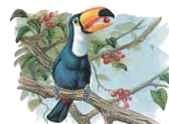
Swallow…
Using its feathery tongue, the toucan positions the berry in the end of its bill, then tosses back its head to tip the food back into its open mouth.
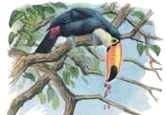
Spit
Although the toucan devours both the seeds and flesh of the berries, it regurgitates any hard seeds that it is unable to digest.
PROFILE
Toco Toucan
Few people who see the toco toucan are likely to forget the sight of its giant bill and vibrant, eye-catching plumage.
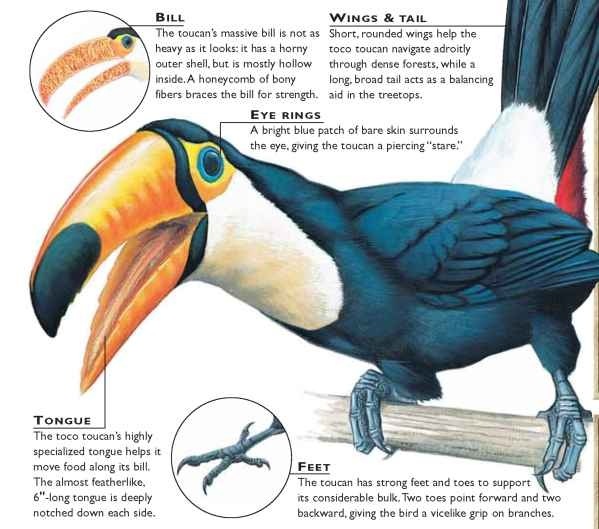
CREATURE COMPARISONS
The toucan family has some of the most striking, colorful birds.The keel-billed toucan (Ramphastos sulfuratus) lives in rainforests from Mexico’ to Venezuela and is in the same genus as the toco toucan. Both have glossy, blue-black feathers on the upperparts, tail and belly, but their bills and “bibs” are very different in colorThe plate-billed mountain toucan (Andigena laminirostris) occurs in forests of the Andes mountain range and has a lighter build than the genus Ramphastos. It’s unique among the toucan family, with a yellow, hornlike plate on each side of its bill; the plate’s function remains a mystery.
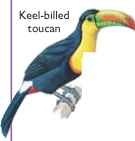
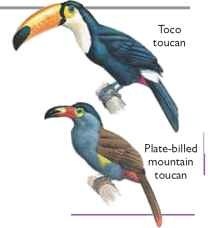
| vital statistics Weight 17.5-10 oz. |
|
| M Length | 24-26.5″ |
| WINGSPAN 19″ | |
| Breeding Season | Varies according to region |
| Number of Eggs | 2-4 |
| Incubation ‘ Period | 16 days |
| Fledging Period | About 49 days |
| Breeding Interval | 1 year |
| Typical DIET ‘ |
Fruit, seeds, insects, spiders; steals eggs, nestlings from smaller birds. Occasionally hunts lizards and snakes |
| Lifespan | Unknown in wild |
Related species
• The 35 toucan species split into 4 tribes in the family Ramphastidae:8 species of “large” toucan; 4 medium-sized mountain species; 2 “small” toucan groups: 13 toucanet and 10 aracari species. All toucans are confined to American tropical forests and have huge bills relative to body size; they belong I to the order Piciformes, which also includes New World barbets woodpeckers, and honeyguides.
